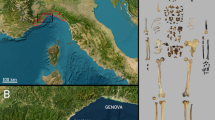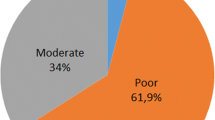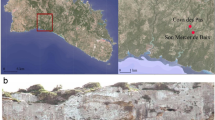Abstract
The Iberian Peninsula is one of the European regions with the highest number of documented Mesolithic burials so far. For more than a century, many research projects have been carried out by several national and international teams, that have located most of these burials in three different geographical areas: Valencia region, northern Spain and the Portuguese estuaries of the Rivers Muge and Sado. Only one inhumation from this period is known in the south of Spain. It was discovered in Nerja Cave (Málaga), an exceptional site with continuous occupations during different periods of prehistory. This burial of a woman, known as ‘Pepita’, is rarely cited in the academic world, probably because the first radiocarbon date was obtained with the conventional 14C method and the result would not be acceptable today. In recent years, the new AMS dates have shown that the Mesolithic chronology was correct. In consequence, a new series of analyses have studied anthropological, diet and mobility aspects of the female in detail. These have provided new information about the time in which Mesolithic communities began to practice a funerary model based on burials in graves, but also about her diet, mobility strategies and possible relationships with other groups. The chronological data show that this is one of the earliest Mesolithic burials in the Western Mediterranean and the diet was based on the consumption of terrestrial animal protein along with marine resources. This type of diet has been found in other contemporary individuals in the east of the Iberian Peninsula.












Similar content being viewed by others
Notes
The terms Mesolithic and Epipalaeolithic are used in the literature. To avoid confusion, and without entering into a debate on the different concepts, the term Mesolithic will be used in a generic sense.
The laboratory code does not appear in the article in which this date was published and therefore it cannot be given here.
References
Al Oumaoui I, Jiménez-Brobeil SA, Souich P (2004) Markers of activity patterns in some populations of the Iberian Peninsula. Int J Osteoarchaeol 14:343–358
Aparicio J (2008) La necrópolis mesolítica de El Collado (Oliva-Valencia). Diputación provincial de Valencia, Valencia
Arias P (2005/2006) Determinaciones de isótopos estables en restos humanos de la región Cantábrica. Homenaje a Jesús Altuna. Munibe (Antropologia-Arkeologia) 57(3):359–374
Arias P (2006) Determinaciones de isótopos estables en restos humanos de la región Cantábrica: aportación al estudio de la dieta de las poblaciones del Mesolítico y el Neolítico. Munibe 57:359–374
Arias P (2013) Los últimos cazadores. El Mesolítico asturiano visto desde la cueva de Los Canes. In De Blas-Cortina MA (ed.) De Neandertales a albiones: cuatro lugares esenciales de la Prehistoria en Asturias: 37–69
Arias P, Garraldoa MD (1996) Mesolithic burials in Los canes cave (Asturias, Spain). Hum Evol 11:129–138
Arnaud J (1987) Os concheiros mesolíticos dos vales do Tejo e Sado: semelhanças e dissmelhanças. Arqueologia 15:53–64
Aura JE, Jordá J, Pérez M, Morales JV, García O, González J, Avezuela B (2009) Epipaleolítico y mesolítico en Andalucía oriental. Primeras notas a partir de los datos de la Cueva de Nerja (Málaga). El Mesolítico Geométrico en la Península Ibérica. Monografías Arqueológicas 44:343–360
Bicho N (2009) Sistemas de povoamento, subsistência e relações sociais dos últimos caçadores-recolectores do Vale do Tejo. Estudos Arqueológicos de Oeiras 17:133–156
Bicho N, Umbelino U, Detry C, Pereira T (2010) The emergence of the Muge Mesolithic shellmiddens (Central Portugal) and the 8200 cal yr BP cold event. Journal of Island and Coastal Archaeology 5:86–104
Bonsall C (2012) Burial practices in the Iron Gates Mesolithic. In: Kogalniceanu R, Curca RG, Gligor M, Stratton S, editors. Homines, Funera, Astra. Proceedings of the International Symposium on Funerary Anthropology (5–8 June 2011, Romania). British Archaeological Reports -International Series- S2410: 45–56
Briggs LC (1955) The stone age races of Northwest Africa. Peabody Museum Harvard University, Cambridge
Brisset E, Burjachs F, Navarro BJB, de Pablo JFL (2018) Socio-ecological adaptation to early-Holocene Sea-level rise in the western Mediterranean. Glob Planet Chang 169:156–167
Bronk Ramsey C (2009) Bayesian analysis of radiocarbon dates. Radiocarbon 51(1):337–360
Brown TA, Nelson DE, Vogel JS, Southon JR (1988) Improved collagen extraction by modified Longin method. Radiocarbon 30:171–177
Buikstra J, Ubelaker D (1994) Standards for data collection from human skeletal remain. Arkansas Archeological Survey Research, Fayetteville
Byers S (2005) Introduction to forensic anthropology. Allyn and Bacon, Boston
Chamla MC (1975) Les hommes des sépultures protohistoriques et puniques d’Afrique du Nord (Algérie et Tunisie). L’Anthropologie 79(4):659–692
Contreras DA, Meadows J (2014) Summed radiocarbon calibrations as a population proxy: a critical evaluation using a realistic simulation approach. J Archaeol Sci 52:591–608
Coppa A, Cucina A, Lucci M, Mancinelli D, Vargiu R (2007) Origins and spread of agriculture in Italy: a nonmetric dental analysis. Am J Phys Anthropol 133:918–930
Cox M (2000) Assessment of parturition. In: Cox M, Mays S (eds) Human osteology in archaeology and forensic science. Greenwich Medical Media, London, pp 131–142
de-la-Rúa C, Izagirre N., Alonso S., Hervella M. (2017) Caracterización genética de la mujer mesolítica del yacimiento de Aizpea (Navarra). In Fernández J, Mujika JA, Arrizabalaga A, García M, Zapata L (eds). Miscelánea en Homenaje a Lydia Zapata Peña (1965-2015), pp. 319–340
Díaz-Zorita M, Beck J, Bocherens H, Díaz del Río P (2018) Isotopic evidence for large scale human aggregations in Copper age Iberia. The mega-site of Marroquíes (Jaén, Spain). Antiquity 92(364):991–1007
Drak L, Garralda MD, Arias P (2020) Los canes Mesolithic burials: archaeothanatology. J Archaeol Sci Rep 32:102381. https://doi.org/10.1016/j.jasrep.2020.102381
Dudzik D, Kolatorowicz A (2016) Craniometric data analysis and estimation of biodistance. In: Pilloud MA, Hefner JT (eds) Biological distance analysis: forensic and bioarchaeological perspectives. Academic Press, New York, pp 35–60
Elder E (2010) A comparison of the Late Pleistocene and Early Holocene burials of North Africa and Western Europe: grim investigations: reaping the dead. Br Archaeol Rep -Int Series- S2143.
Ferembach D (1974) Le gisement mésolitique de Moita do Sebastião (Muge, Portugal). II. Anthropologie. Direção Geral dos Asuntos Culturais. Lisboa.
Fernández López de Pablo J (2010) The impact of the 8,200 cal BP climatic event on human mobility strategies during the Iberian late Mesolithic. J Anthropol Res 66(1):39–68
Fernández-López de Pablo J, Salazar D, Subirà ME, Roca C, Gómez M, Richards MP, Esquembre MA (2013) Late mesolithic burilas at casa Corona (Villena, Spain): direct radiocarbon and palaeodietary evidence of the last forager populations in eastern Iberia. J Archaeol Sci 40:671–680
Flohr S, Schultz M (2009) Osseous changes due to mastoiditis in human skeletal remains. Int J Osteoarchaeol 19:99–106
García-Borja P, Salazar DC, Jordá JF, Pérez M, Aura JE (2018) El inicio del Neolítico en la cueva de Nerja y la Cova de la Sarsa. Contexto arqueológico y dataciones radiocarbónicas. Pyrenae 49(2):7–36
García-Guixé E, Richards MP, Subirà ME (2006) Palaeodiets of human and fauna at the Spanish Mesolithic site of El Collado. Curr Anthropol 47:549–556
García-Sánchez M (1982) El esqueleto epipaleolítico de la “Cueva de Nerja” (Málaga). Cuadernos de Prehistoria de la Universidad de Granada 7:37–71
Gibaja JF, Subirà ME, Terradas X, Santos FJ, Agulló L, Gómez-Martínez I, Allièse F, Fernández-López De Pablo J (2015) The emergence of Mesolithic cemeteries in SW Europe: insights from the El Collado (Oliva, Valencia, Spain) radiocarbon record. PLoS One 10(1):e0115505. https://doi.org/10.1371/journal.pone.0115505
Grandal A, Vidal JR (2017) Caracterización isotópica de Elba: la mujer mesolítica de Chan do Lindeiro (Pedrafita, Lugo, Península Ibérica). Cadernos do Laboratorio Xeolóxico de Laxe: Revista de xeoloxía galega e do hercínico peninsular 39:89–110
Grünberg JM, Gramsch B, Larsson L, Orschiedt J, Meller H (2016) Mesolithic burials – rites, symbols and social organisation of early postglacial communities. Tagungen des Landesmuseums für vorgeschichte Halle (Germany).
Higham TFG, Jacobi RM, Bronk Ramsey C (2006) AMS radiocarbon dating of ancient bone using ultrafiltration. Radiocarbon 48(2):179–195
Howells WW (1989) Skull shapes and the map. Harvard University Press, Cambridge
Isern N, Fort J, Carvalho AF, Gibaja JF, Ibáñez JJ (2014) The Neolithic transition in the Iberian Peninsula: data analysis and modeling. J Archaeol Method Theory 21:447–461
Isern N, Zilhão J, Fort J, Ammerman AJ (2017) Modeling the role of voyaging in the coastal spread of the early Neolithic in the West Mediterranean. Proc Natl Acad Sci U S A 114(5):897–902
Jiménez-Brobeil SA (1988) Estudio antropológico de las poblaciones neolíticas y de la Edad del Cobre en la Alta Andalucía. PhD Thesis. Universidad de Granada. Granada.
Jordá JF, Aura JE (2006) Radiocarbono, cronoestratigrafía y episodios ocupacionales en el Pleistoceno superior y Holoceno de la Cueva de Nerja (Málaga, Andalucía, España). Miscelánea en Homenaje a Victoria Cabrera. Museo Arqueológico Regional, Comunidad de Madrid, Zona Arqueológica 7(1):579–595
Jordá JF, Aura JE (2008) 70 fechas Para una cueva. Revisión crítica de 70 dataciones C14 del Pleistoceno superior y Holoceno de la Cueva de Nerja (Málaga, Andalucía, España). Espacio, Tiempo y Forma Serie I, Nueva época Prehistoria y Arqueología (1):239–256
Jordá JF, Aura JE, Jordá F (1990) El límite Pleistoceno - Holoceno en el yacimiento de la Cueva de Nerja (Málaga). Geogaceta 8:102–104
Knussmann R (1988) Anthropologie. Handbuch der vergleichenden Biologie des menschen. G. Fischer, Stuttgart-New York
Larsson L (1990) The Mesolithic of southern Scandinavia. J World Prehist 4:257–309
Longin R (1971) New method of collagen extraction for radiocarbon dating. Nature 230:241–242
López-Onaindia D, Gibaja JF, Subirà ME (2019) Heirs of the glacial maximum: dental morphology suggests Mesolithic human groups along the Iberian Peninsula shared the same biological origins. Archaeol Anthropol Sci 11:5499–5512
López-Quintana JC, Guenaga A, Etxeberria F, Herrasti L, Martínez de Pancorbo MA, Palencia L, Valverde L, Cardoso S (2015) Nuevos datos sobre la secuencia de uso sepulcral de la Cueva de Santimamiñe (Kortezubi, Bizkaia). ARPI. Homenaje a Rodrigo de Balbín Behrmann 3(extra):180–196
Madrigal L (1998) Statistics for anthropology. Cambridge University Press, Cambridge
Martín D, Camalich MD, Caro JL, Rodríguez FJ (2018) The beginning of the Neolithic in Andalusia. Quat Int 470:451–471
Martins H, Oms FX, Pereira L, Pike AWG, Rowsell K, Zilhão J (2015) Radiocarbon dating the beginning of the Neolithic in Iberia: new results, new problems. J Mediterr Archaeol 28(1):105–131
Meiklejohn C, Petersen EB, Alexandersen V (1998) The Later Mesolithic population of Sjaelland, Denmark, and the Neolithic transition. In: Zvelebil M, Domanska L, Denell R (eds) Harvesting the sea, farming the forest: the emergence of Neolithic societies in the Baltic region. Sheffield Academic Press, pp. 203–212.
Mendonça C (2000) Estimation of height from the length of long bones in a Portuguese adult population. Am J Phys Anthropol 112:39–48
Monge-Soares AM, Dias JMA (2006) Coastal upwelling and radiocarbon. Evidence for temporal fluctuations in ocean reservoir effect off Portugal during the Holocene. Radiocarbon 48(1):45–60
Monge-Soares AM, Gutiérrez-Zugasti I, González-Morales M, Matos-Martins JM, Cuenca-Solana D, Bailey G (2016) Marine radiocarbon reservoir effect in late Pleistocene and early Holocene coastal waters off northern Iberia. Radiocarbon 58(4):869–882
Norusis MJ (1986) Advanced statistics. SPSS/PC +. For the IBM PC/XT/AT. SPSS Inc, Chicago.
Olaria C (2010) El asentamiento mesolítico final y neolítico antiguo del Cingle del Mas Nou. In: Pérez A, Soler B (eds), Restos de vida, restos de muerte. Museu de Prehistòria de València, pp. 175-178.
Pellicer M, Acosta P (1986) Neolítico y Calcolítico en la Cueva de Nerja. In: Jordá JF (ed.) La Prehistoria de la Cueva de Nerja. Trabajos sobre la Cueva de Nerja 1. Málaga: Patronato de la Cueva de Nerja.
Pellicer M, Acosta P (1995) Nociones previas arqueológicas de la Cueva de Nerja. In Pellicer M, Morales A (eds), Fauna de la Cueva de Nerja I. Trabajos sobre la Cueva de Nerja 5. Málaga: Patronato de la Cueva de Nerja.
Peña D (2002) Análisis de datos multivariantes. Mc Graw-Hill, Madrid
Peyroteo R (2016) On death in the Mesolithic or the mortuary practices of the last hunter-gatherers of the south-western Iberian Peninsula, 7th-6th millennium BCE. Occas Pap Archaeol 60.
Pons-Branchu E, Sanchidrián JL, Fontugne M, Medina-Alcalde MA, Quiles A, Thil F, Valladas H (2020) U-series dating at Nerja cave reveal open system. Questioning the Neanderthal origin of Spanish rock art. J Archaeol Sci 117:105120
Reimer PJ, McCormac FG, Moore J, McCormick F, Murray EV (2002) Marineradiocarbon reservoir corrections for the mid to late Holocene in the eastern subpolar North Atlantic. The Holocene 12:129–135
Reimer PJ, Bard E, Bayliss A, Beck JW, Blackwell PG, Bronk Ramsey C, Buck CE, Cheng H, Edwards RL, Friedrich M, Grootes PM, Guilderson TP, Haflidason H, Hajdas I, Hatte C, Heaton TJ, Hoffmann DL, Hogg AG, Hughen KA, Kaiser KF, Kromer B, Manning SW, Niu M, Reimer RW, Richards DA, Scott EM, Southon JR, Staff RA, Turnery CS, Van der Plich J (2013) IntCal13 and Marine13 radiocarbon age calibration curves 0–50,000 years cal BP. Radiocarbon 55:1869–1887
Richards MP, Hedges REM (1999) Stable isotope evidence for similarities in the types of marine foods used by late Mesolithic humans at sites along the Atlantic Coast of Europe. J Archaeol Sci 26(7):717–722
Riquet R (1962) Les crânes préhistoriques de la collection Héléna (Narbonne). Bull Mém Soc Anthrop Paris 3-4:480–522
Salazar-García D, Aura JE, Olaria C, Talamo S, Morales JV, Richards DA (2014) Isotope evidence for the use of marine resources in the eastern Iberian Mesolithic. J Archaeol Sci 42:231–240
Salazar-Garcıa DC, Perez-Ripoll M, Garcıa-Borja P, Jordà J, Aura JE (2017) A terrestrial diet close to the coast: a case study from the Neolithic levels of Nerja Cave (Málaga, Spain). Times of Neolithic transition along the Western Mediterranean, fundamental issues in Archaeology, pp. 281–307
Sanchidrián JL, Márquez AM (2005) Primeros resultados de la secuencia crono-estratigráfica de la Sala de la Torca de la Cueva de Nerja (Málaga, España). In: Sanchidrián JL, Márquez AM, Fullola JM (eds) IV Simposio de Prehistoria Cueva de Nerja. La Cuenca Mediterránea durante el Paleolítico Superior 38000-10000 años. Reunión de la VIII Comisión del Paleolítico Superior U.I.S.P., Fundación Cueva de Nerja, pp. 272–282
Sarasketa I, Villalba V, Le Roux P, Arrizabalaga Á, Salazar DC (2018) Late Neolithic-chalcolithic socio-economical dynamics in northern Iberia. A multi-isotope study on diet and provenance from Santimamiñe and Pico Ramos archaeological sites (Basque Country, Spain). Quat Int 481:14–27
Scott GR, Anta A, Schomberg R, de la Rúa C (2013) Basque dental morphology and the “Eurodont” dental pattern. In: Scott GR, Irish JD (eds) Anthropological perspectives on tooth morphology. Cambridge University Press, Cambridge, pp 296–318
Siani G, Paterne M, Arnold M, Bard E, Métivier B, Tisnerat N, Bassinot F (2000) Radiocarbon reservoir ages in the Mediterranean Sea and Black Sea. Radiocarbon 42:271–280
Turbón D (1981) Antropología de Cataluña en el II milenio a.C. Universidad de Barcelona, Barcelona
Turbón D, Pérez-Pérez A, Lalueza C (1994) Los restos humanos del nivel solutrense de la Cueva de Nerja (Málaga). Actas del VIII Congreso de la Sociedad Española de Antropología Biológica. Universidad Autónoma de Madrid, pp. 51–62
Turner CG, Nichol CR, Scott R (1991) Scoring procedures for key morphological traits of the permanent dentition: the Arizona State University dental anthropology system. In: Kelley MA, Larsen CS (eds) Advances in dental anthropology. Wiley and Liss, New York, pp 13–31
Van Klinken GJ (1999) Bone collagen quality indicators for palaeodietary and radiocarbon measurements. J Archaeol Sci 26:687–695
Vidal JM, Prada ME (2010) Los hombres mesolíticos de la Cueva de la Braña-Arintero (Valdelugueros, León). Estudios y Catálogos de la Junta de Castilla y León 18:176
Vidal JM, Prada M, Fuertes N, Fernández C (2010) Los hombres mesolíticos de la Braña-Arintero (Valdelugueros, León): el hallazgo, situación, aspectos arqueo-antropológicos, cronología y contexto cultural In Vidal JM, Prada ME (eds.) Los hombres mesolíticos de la cueva de La Braña-Arintero (Valdelugueros, León): 16–62
Villotte S, Knüsel CJ (2013) Understanding entheseal changes: definition and life course changes. Int J Osteoarchaeol 23:135–146
Ward GK, Wilson SR (1978) Procedures for comparing and combining radiocarbon age determinations: a critique. Archaeometry 20(1):19–31
Williams AN (2012) The use of summed radiocarbon probability distributions in archaeology: a review of methods. J Archaeol Sci 39(3):578–589
Zilhao J (2011) Time is on my side. In: Hadjikoumis A, Robinson E, Viner S (eds.). The dynamics of neolithisation in Europe. Oxbow books, pp. 46–65
Acknowledgements
The 1982 excavation was one of the last archaeological activities funded by the Cueva de Nerja Trust and authorised by the Ministry of Education and Culture. Later work has been carried out under the custody of the Culture Department of the Government of Andalusia. Strontium analyses were financed by the Institutional Strategy of the University of Tübingen (Deutsche Forschungsgemeinschaft, ZUK 63) and the MWK Research Seed Capital RiSC Programme from the Baden-Württemberg Ministry of Science, Research and Arts. Corina Knipper, Sandra Kraus, Sigrid Klaus and Bernd Höppner at the Curt Engelhorn Center Archaeometry gGmbH, Mannheim, Germany are kindly thanked for the processing and measurement of strontium isotope samples. We are especially thankful to Museo de Nerja and Cueva de Nerja Foundation.
Funding
This research was funded by the projects HAR2011-23149, HAR2015-67323-C2-1-P, HAR2015-67323-C2-2-P and HAR2016-75201-P of the Spanish Science and Innovation Ministry.
Author information
Authors and Affiliations
Corresponding author
Additional information
Publisher’s note
Springer Nature remains neutral with regard to jurisdictional claims in published maps and institutional affiliations.
We refer to ‘formal burials’. In Spain and Portugal, there are a few examples of older Mesolithic with not scattered human remains found in archaeological layers.
Rights and permissions
About this article
Cite this article
Fernández, LE., Sanchidrián, J.L., Jiménez-Brobeil, S.A. et al. Mesolithic human remains at Cueva de Nerja (Málaga, Spain): anthropological, isotopic and radiocarbon data. Archaeol Anthropol Sci 12, 250 (2020). https://doi.org/10.1007/s12520-020-01207-x
Received:
Accepted:
Published:
DOI: https://doi.org/10.1007/s12520-020-01207-x




